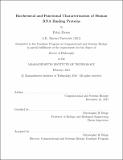| dc.contributor.advisor | Christopher B. Burge. | en_US |
| dc.contributor.author | Freese, Peter (Peter Dale) | en_US |
| dc.contributor.other | Massachusetts Institute of Technology. Computational and Systems Biology Program. | en_US |
| dc.date.accessioned | 2018-05-23T15:04:09Z | |
| dc.date.available | 2018-05-23T15:04:09Z | |
| dc.date.copyright | 2018 | en_US |
| dc.date.issued | 2018 | en_US |
| dc.identifier.uri | http://hdl.handle.net/1721.1/115601 | |
| dc.description | Thesis: Ph. D., Massachusetts Institute of Technology, Computational and Systems Biology Program, 2018. | en_US |
| dc.description | This electronic version was submitted by the student author. The certified thesis is available in the Institute Archives and Special Collections. | en_US |
| dc.description | Cataloged from student-submitted PDF version of thesis. | en_US |
| dc.description | Includes bibliographical references (pages 205-226). | en_US |
| dc.description.abstract | RNA not only shuttles information between DNA and proteins but also carries out many other essential cellular functions. Nearly all steps of an RNA's life cycle are controlled by approximately one thousand RNA binding proteins (RBPs) that direct RNA splicing, cleavage and polyadenylation, localization, translation, and degradation. Despite the central role of RBPs in RNA processing and gene expression, they have been less well studied than DNA binding proteins, in part due to the historical dearth of technologies to probe RBP binding and activity in a high-throughput, comprehensive manner. In this thesis, I describe the affinity landscapes of the largest set of human RBPs to date elucidated through a highthroughput version of RNA Bind-N-Seq (RBNS), an unbiased in vitro assay that determines the primary sequence, secondary structure, and contextual preferences of an RBP. The 78 RBPs bound an unexpectedly low diversity of RNA motifs, implying convergence of binding specificity toward a small set of RNA motifs characterized by low compositional complexity. Offsetting the low diversity of sequence motifs, extensive preferences for contextual features beyond short linear motifs were observed, including bipartite motifs, flanking nucleotide content, and preference for or against RNA structure. These features likely refine which motif occurrences are selected in cells, enabling RBPs that bind the same linear motif to act on distinct subsets of transcripts. Additionally, RBNS data is integrated with complementary in vivo binding sites from enhanced crosslinking and immunoprecipitation (eCLIP) and functional (RNAi/RNA-seq) data produced through collaborative efforts with the ENCODE consortium. These data enable creation of "RNA maps" of RBP activity in pre-mRNA splicing and gene expression levels, either with (eCLIP) or without (RBNS) crosslinking-based assays. The mapping and characterization of RNA elements recognized by over 200 human RBPs is also presented in two human cell lines, K562 and HepG2 cells. Together, these novel data augment the catalog of functional elements encoded in the human genome to include those that act at the RNA level and provide a basis for how RBPs select their RNA targets, a fundamental requirement in more fully understanding RNA processing mechanisms and outcomes. | en_US |
| dc.description.statementofresponsibility | by Peter Freese. | en_US |
| dc.format.extent | 226 pages | en_US |
| dc.language.iso | eng | en_US |
| dc.publisher | Massachusetts Institute of Technology | en_US |
| dc.rights | MIT theses are protected by copyright. They may be viewed, downloaded, or printed from this source but further reproduction or distribution in any format is prohibited without written permission. | en_US |
| dc.rights.uri | http://dspace.mit.edu/handle/1721.1/7582 | en_US |
| dc.subject | Computational and Systems Biology Program. | en_US |
| dc.title | Biochemical and functional characterization of human RNA binding proteins | en_US |
| dc.type | Thesis | en_US |
| dc.description.degree | Ph. D. | en_US |
| dc.contributor.department | Massachusetts Institute of Technology. Computational and Systems Biology Program | |
| dc.identifier.oclc | 1036985900 | en_US |
